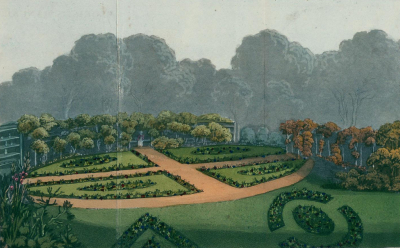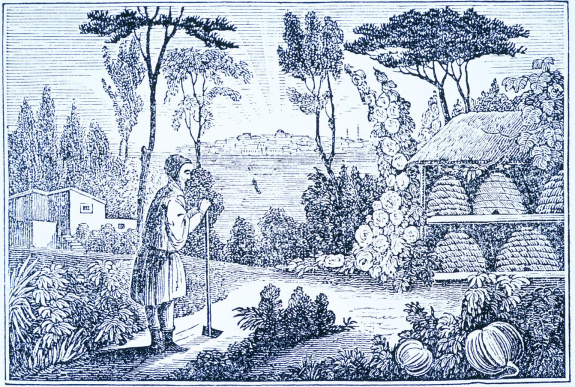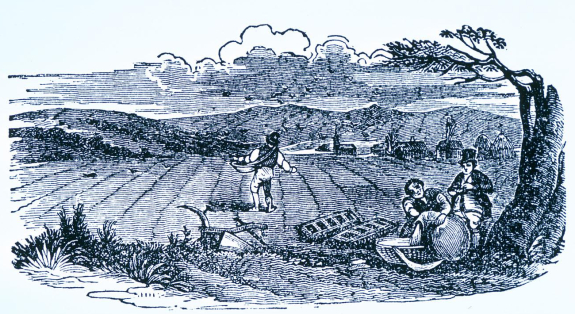
Early New England Gardens
A few months ago, we
checked out PBS's Colonial
House on
Netflix. The reality TV show plunks a few families down in New
England where they replicate what life was like in Plymouth Colony in
1628. Although the series was interesting, I was sorely
disappointed by the lack of time spent focusing on the gardens ---
that's the whole point of a reality TV show about the past,
right? Early
New
England Gardens: 1620 - 1840, a little booklet put out by
Old Sturbridge Village, filled in the
gaps.
The early American
colonist generally had two separate gardens.
First, a house plot (also known as a merestead) was equivalent to our
kitchen garden. It was placed right by the house and was full of
vegetables, herbs, and flowers used every day. Further off, the
settlement fields were planted with large-scale crops --- the staples
backyard gardeners don't often grow much of anymore, like field corn,
parsnips, turnips, beans (for drying), pumpkins, and cabbage.
Personally, I've found that putting a garden any further than two steps
out the front door means that it gets neglected (and eaten by deer),
but I guess these colonists felt the need to concentrate their houses
close together for mutual protection.
There were two general
patterns evident in meresteads in early New
England --- the cottage garden style and the formal garden style.
The former predominated in the Plymouth colony and among the poorer
colonists while the latter was more common in Massachusetts Bay colony
and among richer folks.
I've described cottage
gardens in a
previous lunchtime series --- you may remember that
cottage gardens are a very informal hodgepodge of plants and animals,
with herbs, flowers, vegetables, fruits, and even pigs and bees mashed
together in a small space. The people who settled in Plymouth
Colony believed that gardens should be austere and utilitarian, and
that flowers with no use were frivolous and extravagant. The
booklet notes, "There was actually an early Connecticut statute
declaring it unlawful to walk in the garden on the Sabbath."
 In contrast, the more
prosperous Massachusetts Bay colonists based
their gardens on the English manor garden. There was usually a
long central path, ending at an arbor, summer house, or dovecote.
Beds along the side were usually linear (though still informally
planted with mixtures of plants).
In contrast, the more
prosperous Massachusetts Bay colonists based
their gardens on the English manor garden. There was usually a
long central path, ending at an arbor, summer house, or dovecote.
Beds along the side were usually linear (though still informally
planted with mixtures of plants).
As New England colonies
became more prosperous in the eighteenth century, the more formal type
of
garden became widespread. Soon, flowers were separated out
of the vegetable gardens and the layout began to resemble the American
landscape seen today. Most houses had a large front garden
composed purely of flowers and/or lawn running down a path to their
front
gate, with the vegetables tucked away out of sight.
As a final note, all of
the photos in this week's lunchtime series
come from Old Sturbridge Village's website. I got a bit lost
browsing their images and comparing colonial life
to my life. If you're bored, you might wander over and look for a
while too.
| This post is part of our Early New England Gardens lunchtime series.
Read all of the entries: |
Want more in-depth information? Browse through our books.
Or explore more posts by date or by subject.
About us: Anna Hess and Mark Hamilton spent over a decade living self-sufficiently in the mountains of Virginia before moving north to start over from scratch in the foothills of Ohio. They've experimented with permaculture, no-till gardening, trailersteading, home-based microbusinesses and much more, writing about their adventures in both blogs and books.
Want to be notified when new comments are posted on this page? Click on the RSS button after you add a comment to subscribe to the comment feed, or simply check the box beside "email replies to me" while writing your comment.



Maggie --- it's both. You can read it for free on the website, or buy the ebook.
Mom --- I'm sure you're right! My history is shoddy. The booklet seemed to be suggesting that they were Puritans, but maybe they were just referring to the influence of other Puritans in the area.